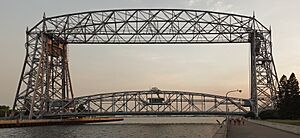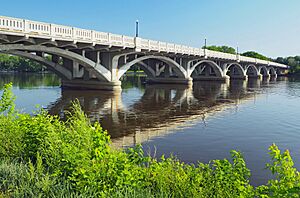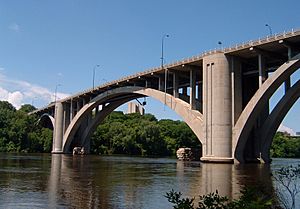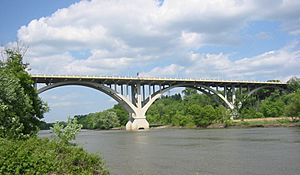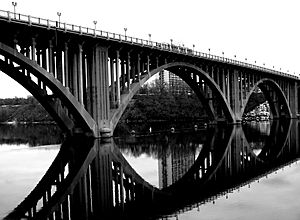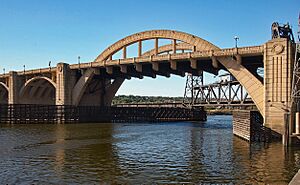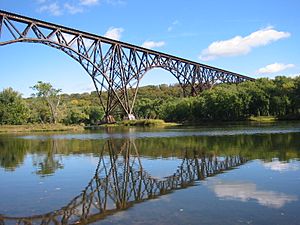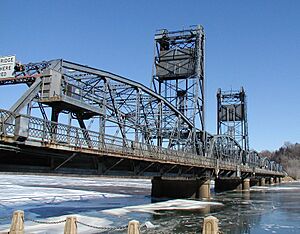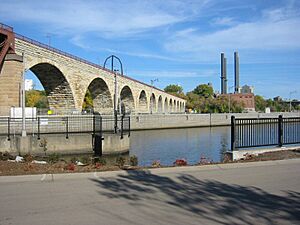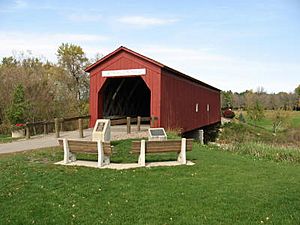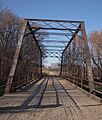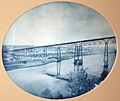List of bridges on the National Register of Historic Places in Minnesota facts for kids
Minnesota is home to many amazing bridges, and some of them are so special that they are listed on the National Register of Historic Places. This is a list of important places in the U.S. state of Minnesota that are recognized for their history and unique design. These bridges are like cool old landmarks that tell us stories about how people traveled and built things in the past.
Contents
Historic Bridges in Minnesota
Minnesota has many bridges that are important because of their history, how they were built, or what they look like. Being on the National Register of Historic Places means these bridges are protected and celebrated for their special value. Let's explore some of these cool structures!
What Makes a Bridge Historic?
A bridge becomes historic when it's old and has a special story. Maybe it was built using a new technique for its time, or it's a great example of a certain style of bridge. Some bridges are important because they helped connect communities or were part of big changes in transportation. When a bridge is added to the National Register, it means experts agree it's worth preserving for future generations to learn from and enjoy.
Famous Bridges You Can See
- The Aerial Lift Bridge in Duluth is super cool! It was built in 1901 and changed in 1929 to become a "vertical lift" bridge. This means a whole section of the bridge can go up and down to let tall ships pass underneath. It's a famous landmark in Duluth.
- The Anoka–Champlin Mississippi River Bridge connects the towns of Anoka and Champlin. Built in 1929, it's a concrete arch bridge, which means it uses strong, curved concrete sections to hold itself up.
- The Cappelen Memorial Bridge in Minneapolis is also known as the Franklin Avenue Bridge. It was built in 1919 and is a "parabolic-arch" bridge, known for its beautiful, graceful curves.
- The Fort Snelling-Mendota Bridge connects Mendota and Minneapolis. Built between 1925 and 1926, it's another impressive concrete arch bridge that crosses the Minnesota River.
- The Intercity Bridge, also called the Ford Parkway Bridge, links Minneapolis and Saint Paul. This concrete arch bridge was built in 1927 and is an important connection between the two big cities.
- The Robert Street Bridge in Saint Paul is a concrete arch bridge from 1926. It's a key part of the city's transportation system.
- The Soo Line High Bridge near Stillwater is a really tall steel bridge built between 1910 and 1911. It's a "steel deck arch" bridge, meaning the main roadway is supported by a large, curved steel structure underneath.
- The Stillwater Bridge is another vertical lift bridge, like the one in Duluth. Built in 1931, it crosses the St. Croix River near Stillwater.
- The Stone Arch Bridge in Minneapolis is a famous landmark. Built in 1883, it's a beautiful stone arch bridge that used to carry trains and now is a popular walking and biking path with great views of the city skyline and St. Anthony Falls.
- The Zumbrota Covered Bridge in Zumbrota is very old, built in 1869 and 1871. It's a "Town lattice truss" bridge, which is a special way of building with crisscrossing wooden beams. It's one of the few remaining covered bridges in Minnesota.
Different Kinds of Bridges
Bridges come in many shapes and sizes, each designed for a specific purpose. Here are some types you'll find among Minnesota's historic bridges:
- Arch Bridges: These bridges use a curved structure to support the weight. You can see them in concrete (like the Anoka-Champlin Bridge) or stone (like the Stone Arch Bridge).
- Truss Bridges: These bridges use a framework of connected triangles, called a truss, to distribute weight. Different patterns of triangles give them names like "Pratt through truss" or "Warren pony truss."
- Lift Bridges: These bridges have a section that can be raised vertically to allow boats to pass, like the Aerial Lift Bridge in Duluth.
- Girder Bridges: These bridges use strong beams (girders) to support the deck. They can be made of steel or concrete.
- Culverts: While often smaller, some historic culverts are also recognized. A culvert is a tunnel-like structure that allows water to flow under a road or railway.
Bridges That Were Once Listed
Sometimes, a bridge that was once on the National Register of Historic Places is later removed. This can happen if the bridge is taken down, or if it's changed so much that it no longer has its original historic look or features. These bridges still have a place in history, even if they are no longer on the official list.
- Bridge No. 1811 over Kettle River (1916) in Rutledge was a Pratt through truss bridge. It was removed from the list in 2005.
- Bridge No. L1409 (1895) in Winona was a stone arch bridge. It was removed in 2016 after being destroyed by flooding in 2007.
- The Selby Avenue Bridge (1890) in Saint Paul was a Pratt through truss bridge. It was removed in 1994.
- The Smith Avenue High Bridge (1889) in Saint Paul was a Warren truss bridge. It was removed in 1988.
- The Wabasha Street Bridge (1890, 1900) in Saint Paul was a cantilever deck truss bridge. It was removed in 1998.
Images for kids


